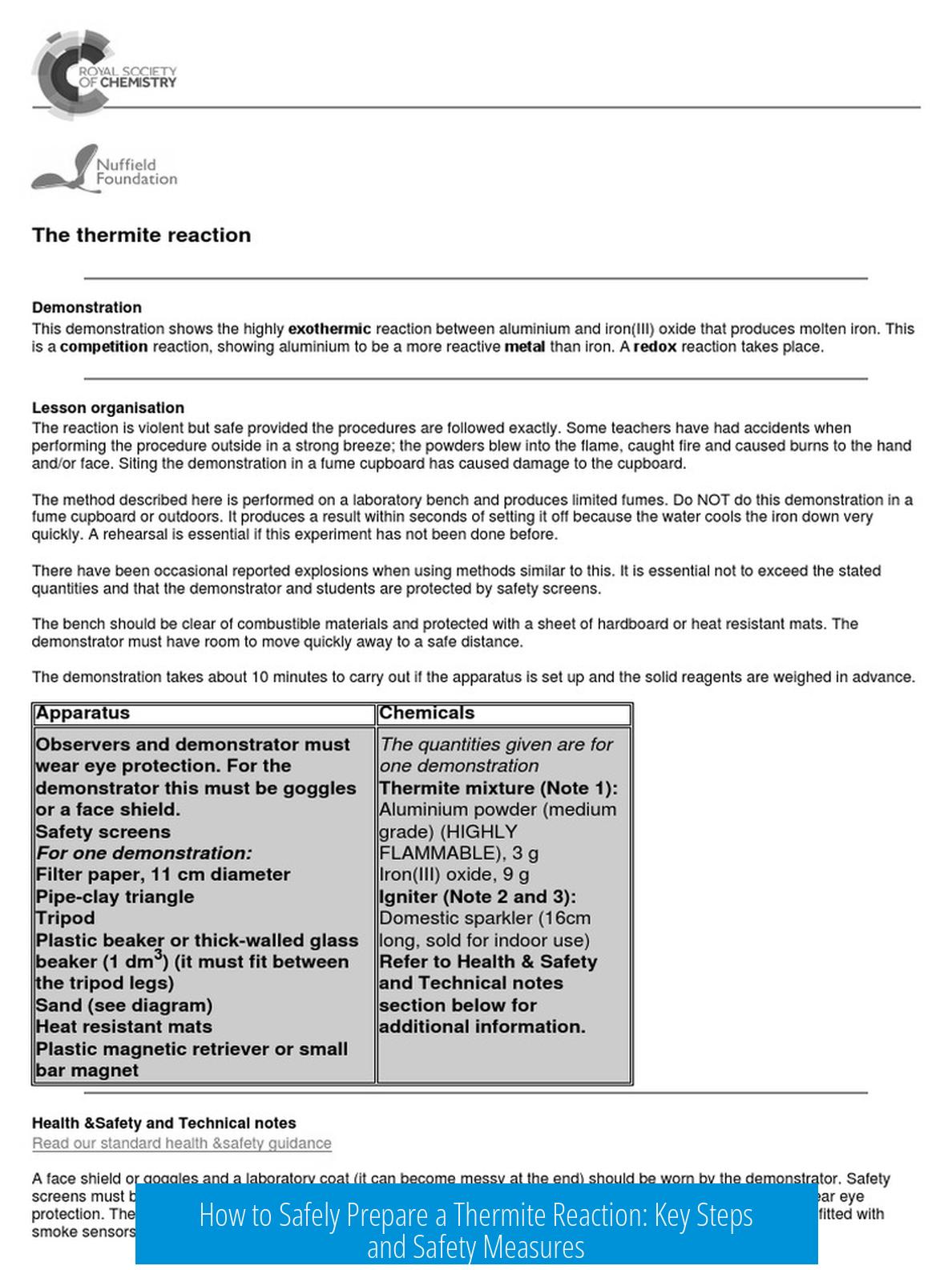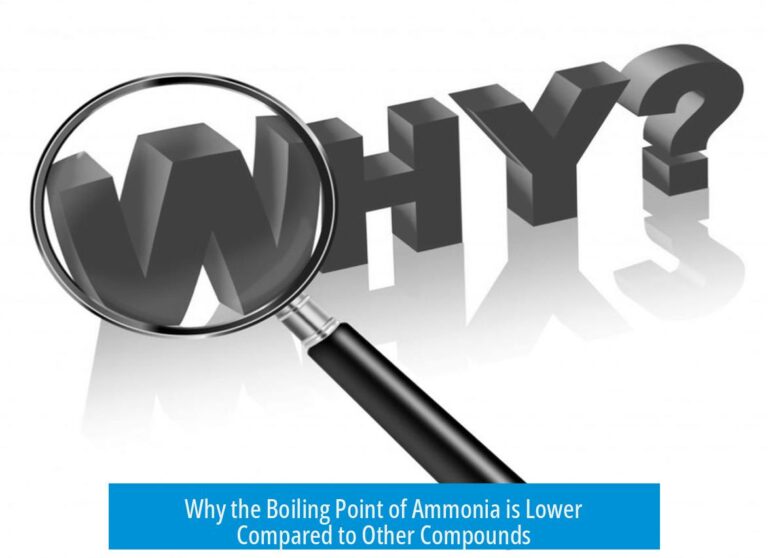How to Safely Prepare a Thermite Reaction
To safely prepare a thermite reaction, one must adhere to established safety protocols, use appropriate equipment, maintain safe distances, and carefully handle reactants and ignition sources. This involves secure containment of the molten materials, controlled quantities of reactants, and detailed preparation of the experimental setup to avoid accidents.
1. Preparation and Setup
Follow Established Guidelines
Always start with verified methods and risk assessments, such as those provided by CLEAPPS and the Royal Society of Chemistry (RSC). These organizations offer detailed protocols used widely in educational and professional settings to minimize hazards.
Choose the Right Equipment and Containers
- Use two earthenware flower pots, stacked. The inner pot holds the reaction, and the outer pot contains cracks or molten material.
- Seal the inner pot’s hole with paper or masking tape; this burns away, allowing molten slag to drop safely.
- Preferably use an old metal saucepan or skillet instead of glass to collect molten iron. Metal withstands heat and prevents breakage.
- Support containers on a ring stand placed over a tray filled with sand to trap molten iron safely.
Sand Setup
- Use a substantial amount of dry sand—approximately 20–25 pounds or more in a large tray.
- Make a hole scooped into the sand directly beneath the reaction site to catch molten iron pools. This prevents dangerous flow and explosions.
- Avoid wet sand to eliminate the risk of steam explosions caused by molten iron’s contact with moisture.
2. Safety Measures
Personal Protective Equipment and Distance
- A blast shield is highly recommended to protect from hot sparks and flying material. If unavailable, maintain a minimum safety distance of 15 feet from the reaction.
- Keep a fire bucket with sand ready to promptly extinguish stray sparks or small fires.
- Although respirators and UV protective glasses are optional, wearing them does not cause harm and can provide additional assurance.
Protecting Observers
- Conduct the demonstration away from buildings, preferably in an open, sandy area to reduce risk to people and structures.
- Place a safety screen between the reaction and onlookers to block sparks and fumes.
Handling Molten Iron Safely
- Collect molten iron by allowing it to drop into water with a sand layer beneath to cool and solidify quickly.
- Beware that small amounts of water can flash boil, causing molten iron to spit and potentially explode. Sufficient water volume is needed to safely quench the metal.
3. Reactants and Handling
Thermite Stability and Mixing
- Thermite mixtures are relatively stable and can be packed into molds for safer transport and handling by reducing dust.
- Mixing the aluminum and iron(III) oxide powders before use is generally safe when done carefully.
- Finer powders ignite easier and produce stronger reactions. Coarser powders may not ignite effectively, especially if ignition relies on a fuse.
Recommended Quantity
- For demonstrations, use about one cup of thermite—a small ceramic crucible filled with thermite is standard.
- Larger quantities increase risk considerably and may cause the reaction to “pop” or spatter molten material dangerously.
4. Ignition Methods
Preferred Ignition Process
Form the thermite powder into a small “volcano” shape. Place potassium permanganate into the crater at the top. Insert a piece of magnesium ribbon through the pile so it protrudes from the top and extends down inside.
When ready, add a few drops of glycerin to the potassium permanganate. The resulting oxidation of glycerin by potassium permanganate generates heat slowly, allowing time to withdraw safely. The heat ignites magnesium, which then ignites the thermite itself, producing a consistent and controlled ignition.
5. Experience and Training
Practice Before Demonstration
Perform dry runs of the thermite reaction before presenting to students or the public to build confidence and familiarity with the procedure.
Seek Expert Guidance
- Engage instructors or experienced professionals who have conducted thermite demonstrations.
- Collaborate with colleagues, such as other teachers or technicians, especially in educational settings, for shared knowledge and safety assurance.
6. Incident Warnings and Cautions
Potential Hazards
- Molten thermite can escape the containment vessel and cause dangerous reactions if it contacts unintended surfaces, such as concrete, resulting in violent sparks and explosions.
- The thermite reaction throws sparks and heated particles. Use blast shields or maintain adequate distance to prevent injuries.
- Improper use of water near molten iron can cause explosive spitting. Always manage water volume carefully.
- Some reports note accidents where reaction vessels were filled with water, injuring observers due to steam and molten metal interaction.
7. Additional Notes
Reaction Control
Very fine powders ignite quickly, potentially making the thermite reaction faster than desired. There is limited ability to slow down the reaction chemically. Adjusting particle size can moderate ignition speed and reaction vigor.
Emphasis on Safety and Caution
Thermite demonstrations require serious attention to safety protocols. Experience is critical; novices should not attempt these reactions without mentorship and practice. Safety measures and risk assessments are essential to prevent accidents.
Summary of Key Points
- Follow established guidelines from CLEAPPS and RSC for risk assessment and procedures.
- Use double earthenware pots with sealed holes and a metal container for molten metal collection.
- Place the reaction setup over a large, dry, sand-filled tray with a scooped hole to catch molten iron.
- Wear protective gear, use blast shields or maintain at least 15 feet distance.
- Use about a cup of thermite per reaction to limit hazards.
- Ignite thermite using a controlled glycerin-potassium permanganate and magnesium ribbon method.
- Practice thoroughly and seek expert mentorship before public demonstrations.
- Beware of molten metal running off, avoiding wet sand and inappropriate water use.
- Recognize the vigorous nature of the thermite reaction; maintain safety and respect for the process.
How should I set up the containers to safely react thermite?
Stack two earthenware flower pots of the same size. Cover the inner pot’s hole with paper or tape. This burns through, letting molten slag drop into sand below. Outer pot contains cracks and keeps slag contained.
What is the best way to manage molten iron after the thermite reaction?
Collect molten iron in an old saucepan or skillet, not glass. Place the setup over deep sand with a scooped hole to catch molten iron. Avoid wet sand to prevent explosions caused by steam.
How can I safely ignite the thermite reaction?
Mold thermite into a small volcano. Add potassium permanganate at the crater. Insert magnesium ribbon through the pile. When ready, drip glycerin on the permanganate. This ignites magnesium, then the thermite reliably.
What personal safety measures are recommended during the thermite reaction?
Use a blast shield or keep over 15 feet distance. Have a fire bucket of sand nearby. Conduct the reaction away from buildings. A safety screen can protect observers from sparks and fumes.
How much thermite should I use for safe demonstrations?
Use about a cup of thermite, enough to fill a small ceramic crucible. Larger amounts risk popping and spitting. Practice the reaction to build confidence and ensure safety before doing it before others.





Leave a Comment